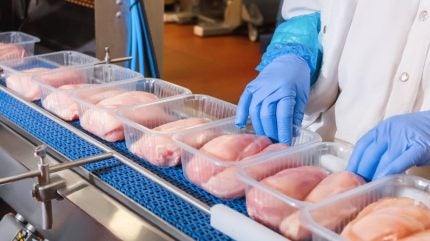
The US Department of Agriculture (USDA) has announced further actions intended to make the domestic poultry market “more competitive, affordable, and transparent”.
Proposed rules under the Packers and Stockyards Act “will support market fairness for contract poultry farmers and expanded data tools will further support cattle market transparency”, it said.
The measures announced yesterday (3 June) are the latest attempt by the Biden administration to tackle perceived inequalities within the poultry and wider meat industries, a sector hit by price-fixing scandals in recent years.
In September 2022, it announced initiatives linked to concerns that the animal protein industry is concentrated in the hands of too few companies and industry players’ practices were aiding inflation and hitting consumers in the pocket.
Reiterating those concerns in yesterday’s announcement, Agriculture Secretary Tom Vilsack said: “Under the direction of President Biden, USDA has sought to utilise every tool at its disposal to uphold fair competition, protect producers, lower costs for consumers and combat unfair, deceptive, and discriminatory practices.”
The newly-announced proposed measures include using Poultry Grower Payment Systems and Capital Improvement Systems to “address a range of abuses that have occurred” in relation to grower payment systems and additional capital investment requirements that poultry companies “commonly ask of their contract growers for broiler chicken”.
Andy Green, USDA’s senior advisor for fair and competitive markets, said: “Poultry growers deserve a fair shake and consumers deserve fair prices. This proposed rule is intended to provide growers with a clear base price in contracts, a contracting partner that designs and operates any comparisons fairly and access to the information that growers – and USDA – need to identify and halt coercive investment demands before growers take on large debts.”
USDA also announced new publicly available cattle market transparency tools.
The agency is launching a new data visualistion tool, the Livestock Mandatory Reporting (LMR) Live Cattle Data Dashboard, which it says provides users with the ability to view and access LMR live cattle market information “in a manner that is easy to use and understand”.
USDA also wants to increase independent meat and poultry processing capacity, expand domestic fertiliser production and create a fairer market for seeds and other agriculture inputs to support a more robust and resilient supply chain.
“These investments will create better economic opportunities, which will result in more affordable prices and choices for consumers at the grocery store, in addition to more opportunities and revenue for producers,” it said.
Responding to USDA’s announcement, Mike Brown, president of industry body the National Chicken Council (NCC), said: “These are solutions in search of problems that do not exist.
“This is the latest example of the Biden administration racing to impose its anti-business regulatory agenda ahead of November’s election.
“This rule – which Congress never asked for – will lead to rigid, one-size-fits-all requirements on chicken-growing contracts that would stifle innovation, lead to higher costs for consumers, decrease competition, and cost jobs by driving some of the best farmers out of the chicken business.”



